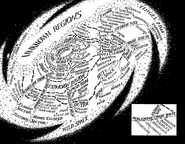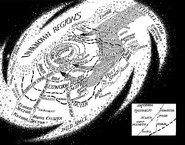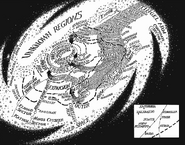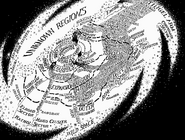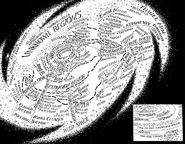- "I have fought the worst of all wars, and witnessed the redemption of evil. I've seen balance restored to the Force. But order can turn to chaos… as it did when I was born. Now, with my loved ones and my loyal allies, I face a new challenge unlike any before. And I'm not sure if this time we can win."
- ―Luke Skywalker
Star Wars: The New Jedi Order, commonly abbreviated as the NJO, is a multi-author book series that was published by Del Rey between 1999 and 2003, consisting of nineteen novels, three eBook novellas, and three short stories. Twelve authors in total contributed to the series, which was a collaborative effort conceived by representatives of Del Rey, Lucasfilm Ltd., and Dark Horse Comics during meetings at Skywalker Ranch in 1997 and 1998. The NJO is a chronological storyline covering a four-year span of galactic history, beginning twenty-one years after the events of Return of the Jedi and telling the story of an invasion of the galaxy by a race of extra-galactic religious zealots.
Within the NJO's pages, the Yuuzhan Vong begin a massive invasion of the galaxy, and quickly gain ground despite efforts at repulsion made by the New Republic and Luke Skywalker's New Jedi Order. Skywalker, Han Solo, Leia Organa Solo, and a new generation of heroes battle the bloodthirsty fanatics as they overtake an unprepared Republic, killing untold numbers of innocents and devastating countless planets, even conquering the galactic capital of Coruscant. Eventually, a rebuilt galactic government, aided by the Jedi and the mysterious living planet Zonama Sekot, overthrow the Yuuzhan Vong and save the galaxy. Characters from the original Star Wars trilogy of films play large roles, as do established Expanded Universe characters and new additions to the galaxy far, far away, all working together to repel the invaders.
As a large-scale project the likes of which Star Wars had never seen before, the NJO was an undertaking that was supervised closely by Lucasfilm Ltd. and kept consistent by a team of continuity advisors. Every book in the series made it onto the New York Times Best Seller List, and paved the way for future multi-author projects such as Legacy of the Force and Fate of the Jedi. Several tie-in sourcebooks, magazine articles, and comic books were published, helping to expand the New Jedi Order era within the Star Wars mythos.
Conception[]
- "It goes against all the safe conditions of putting together a series of books. Safe would have said copy what's happened before. Safe would have said don't do anything bigger than a trilogy. They chose a more gutsy approach. I salute them for it."
- ―R.A. Salvatore
Bantam Spectra and Lucasfilm Ltd. had been publishing Star Wars novels written by various authors throughout the 1990s, beginning with 1991's Heir to the Empire, which quickly reached #1 on the New York Times Best Seller list. Following the book's success, both companies agreed that every subsequent novel would form a part of a larger cohesive continuity.[20] In 1997, the publishing contract for Star Wars novels was renegotiated with Del Rey, the publishing imprint of Ballantine Books, and the decision was made to produce a large series which would take several years to publish.[21][22] Under the Bantam license, the majority of novels released had been trilogies or stand-alones; despite the continuity, many novels were being written simultaneously and published in close succession. This often led to stories which took place later in the timeline being published prior to stories which took place earlier.[23][24][25] The planned Del Rey series, however, would be one large chronological story line covering a five-year span of galactic history.[26]

Shelly Shapiro, one of the chief architects of The New Jedi Order
Dark Horse Comics, which had been contracted to publish Star Wars comics since 1991,[27] conceived of the idea of an "Invasion" storyline rocking the galaxy, and planted the seeds of the eventual story by introducing the character of Nom Anor,[28] who appeared as an advance agent of what would eventually become the invading forces in the first issue of Crimson Empire II: Council of Blood, released in November 1998.[29] Following the conception of Anor's character, planning meetings were held at Skywalker Ranch to discuss what would eventually become The New Jedi Order. Attendants at the meetings included Lucas Licensing Executive Editor Sue Rostoni, Del Rey Editor at Large Shelly Shapiro, Lucasfilm Director of Publishing Lucy Autrey Wilson,[22] Dark Horse Vice President of Publishing Randy Stradley,[28] and several of the authors who were already on board,[30] including Michael A. Stackpole,[31] James Luceno,[32] and several comic-book authors.[33] Stradley suggested the invasion idea,[34] and it quickly became the premise of the series. The invaders were conceived of as being dark Force users.[21]
As many of the novels published under Bantam Spectra had dealt with the New Republic's continuing war against the Empire,[35][36][37] it was decided to introduce a newer, larger, and meaner threat.[38] Shapiro had often heard fans complain that nothing significant happened to any primary character in the novels published by Bantam, and that the galaxy had grown too safe for the heroes, preventing any serious drama from occurring. In the NJO's initial planning sessions, ideas were brainstormed concerning what kind of crisis the characters would face, and everyone present agreed that it was necessary to shake things up by killing a previously "invincible" character.[30] The death of Luke Skywalker was proposed, but the idea was vetoed by George Lucas;[22] Lucas also indicated that C-3PO and R2-D2 were off-limits. It was felt that killing Han Solo, Princess Leia, or Lando Calrissian would not have the dramatic impact that the planning team was looking for, which prompted Stradley to suggest Chewbacca, who, despite being a fan-favorite character, had rarely significantly contributed to a novel's plot; Stradley referred to him as the "quintessential supporting character."[28] It was felt that the death of a previously untouchable character would give the series its needed emotional impact,[19] but putting Chewbacca on the chopping block was not an easy decision on the part of the creative team, causing many tears to be shed.[39] Once the final decision was made, Chewbacca's death was approved by George Lucas.[19]
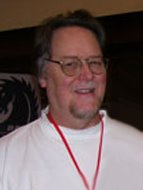
Randy Stradley initially conceived of an "Invasion" storyline, and later suggested that Chewbacca be killed.
It was also decided during the initial planning stages that a new generation of characters would play a large part in the series.[30] The role of the older generation would remain as important, however—Shapiro indicated that one of the stimuli for the series had been that Bantam authors had been unable to develop Han Solo's character.[22] As such, the two generations would star and develop in tandem.[30] At the time, the twin offspring of Han and Leia, Jacen and Jaina Solo, were being developed as Jedi-in-training within the pages of the Young Jedi Knights young reader books,[40] and the youngest Solo child, Anakin, had recently starred in his own young reader books, the Junior Jedi Knights series.[41]
In the early conception of the Bantam/Dark Horse invasion storyline, initially developed in 1997 and 1998, Anakin was slated to be a prophesied hero, who would be tempted to the dark side by a female infiltrator of the extragalactic Sith invaders of the series, and this would result in a love affair between Anakin and this woman. Jacen and Jaina would eventually confront Anakin, and as a result Jacen would be killed.[42] Lucas reviewed this story arc and concluded that it was not original enough, writing in May 1998, "Too redundant to movie storylines - books should be more original."[43] Lucas also had concerns that in this story pitch, Anakin's story would too closely parallel the story of his grandfather, Anakin Skywalker,[44][21] which was to be told in the forthcoming Star Wars prequel trilogy.[45] As a result, Lucas advised that Jacen be the primary protagonist of the series instead of Anakin,[46] although the story team decided independently that Anakin should die in the series at the midway point, which was approved by Lucas in the final outline. Troy Denning later corroborated this in a radio interview, remarking that before Vector Prime was published, it was already written in the story bible of the series that Anakin was slated to die in Star by Star, confirming that this was the intention of the story team before publication of the series began.[47]
Lucas also dictated that the villains could not be Force users, stemming from his belief that the Sith could not form a stable "dark side society,"[21] and with the encouragement of Lucas to be more original, the authors set to work at constructing a new set of villains with a different story arc for the series. The planning team then constructed a rough outline of the plot direction of the NJO, and chose more authors, some of whom were suggested by Shapiro, and some by Lucas Licensing and subsequently approved by her. The planning team had a general idea of how the series would end, but intended the NJO to be an organic and adaptive series, open to new directions and not carved in stone.[30] The story team consciously made use of mythological archetypes and the hero cycle as delineated by Joseph Campbell, among others, in their construction of the series.[21] James Luceno wrote a "series bible" that would coordinate all of the story arcs and function as a database for new characters and continuity.[32][48] A continuity team was formed[49] that included Luceno[48] and Daniel Wallace,[50] who expanded the galaxy map[48] and kept track of new Jedi introduced in the series. They encouraged authors to re-use Jedi in later books rather than inventing new ones.[49] Throughout the series' run, Lucasfilm Ltd. supervised the NJO's production much more closely than they had the Bantam-issued novels.[51]
The series' villains were eventually developed into the Yuuzhan Vong, an extra-galactic race of religious zealots bent on conquering the galaxy. The name "Yuuzhan Vong" was derived from a French-Thai restaurant in New York City where several members of the planning team were eating.[22] R. A. Salvatore, Del Rey editor Steve Saffel, and James Luceno became inspired by Aztec, Mayan, and various Mesoamerican ideas for the creation of the mythology and beliefs of the Yuuzhan Vong.[21] The final outline of the series was reviewed and approved by Lucas, at which point he ceased his involvement with the series. A peace treaty with the remnants of the Empire, and the seeds of an alien invasion plotline, were laid in 1998's Vision of the Future, a novel by Timothy Zahn published under Bantam's contract.[52]
Media[]
| Color code key: | ||||
|---|---|---|---|---|
| Duology/Trilogy | eBook Novella | Short story | Cancelled | |
Related short fiction[]
- "The Crystal" by Elaine Cunningham
- "Red Sky, Blue Flame" by Elaine Cunningham
- "Or Die Trying" by Sean Williams & Shane Dix
Related comics[]
Related nonfiction[]
- Vector Prime television commercial
- The New Jedi Order in 100 Easy Lessons
- The New Jedi Order Sourcebook
- Making a Full Recovery
- Mission to Myrkr
- Who's Who in the New Jedi Order
- Star Wars: New Jedi Order Round-Robin Interview
- Novel Approach
Plot synopsis[]
Twenty-one years after the Rebel Alliance destroyed the second Death Star, the New Republic is facing internal conflict while trying to maintain peace. A new, unknown enemy called the Yuuzhan Vong emerges from the outer galaxy, beginning what will be known as the Yuuzhan Vong War. The Jedi, along with the New Republic, struggle to resist this new alien race while it steadily pushes forward, annihilating or occupying different parts of the galaxy.
Character arcs[]
As the longest continuous series of novels in the Expanded Universe, the NJO established several long-term character arcs. Many new or previously underused characters were put into the spotlight and were developed extensively over the course of the series. Among the most prominent character arcs:
- Jacen Solo: Jacen underwent perhaps the most complete and philosophical arc of the NJO. He began the series as someone who actively questioned whether it was right to use the Force as a weapon. After being captured by the Yuuzhan Vong he withstood weeks of torture at the hands of the Yuuzhan Vong, where upon he is visited and consulted by Vergere, an Old Republic Jedi and Vong familiar. He emerged with a new view of the Force, including a willingness to use it offensively. During the battle to retake Coruscant, Jacen achieved a state of oneness with the Force that gave him a 'perfect mastery' and also aged him five years. At the end of the series, he was one of the most powerful Jedi in the galaxy.
- Ganner Rhysode: Rhysode began the series as an arrogant young Jedi, a trait best shown when, on assignment with Corran Horn, he mocked Horn's inability to use telekinesis, claiming that this made him a lesser Jedi. Rhysode gradually became more humble over the course of the series, especially after watching many of his friends die on the mission to Myrkr. After Jacen Solo was captured during this mission, Rhysode went searching for him, even though, in Jacen's words, "we weren't even friends"; Rhysode died fighting thousands of Yuuzhan Vong warriors so that Jacen and Vergere could escape. It was foreseen that in the future, the Yuuzhan Vong would worship a new god called "the Ganner," referring almost admiringly to Rhysode's last stand.
- Tahiri Veila: Not fully developed in her original role—Anakin's friend from Star Wars: Junior Jedi Knights—Tahiri was pushed to a starring role in the NJO. When the Yuuzhan Vong captured Yavin 4, she was taken prisoner and subjected to experiments designed to create a Vong-Human hybrid. Anakin eventually rescued her, which stirred the romantic feelings they had had for years; when Anakin died above Myrkr, Tahiri was devastated. At this time, the Yuuzhan Vong personality implanted in her began to periodically take control, and Tahiri would wrestle with this for the duration of the series. Unlike most of the other Jedi, she had a peculiar empathy with the Yuuzhan Vong; at the end of the series, she chose to stay on Zonama Sekot in order to continue learning about the Yuuzhan Vong and to help them build a better society.
The New Order vs. the Old Order[]
The Order itself is philosophically distinct from the Jedi Order of the Old Republic (thus the Old Jedi Order) by a new Jedi Code and broadened view of the Force. The Order's titular head is Luke Skywalker, but other senior Jedi such as Kyle Katarn, Mara Jade and Kyp Durron have significant say in the Order's activities. The Order during the Yuuzhan Vong incursion polarizes into two major factions: that of Luke Skywalker, who feels that the Force should be used peacefully, like the Old Republic–era Jedi; and the faction of Kyp Durron, who holds that the Jedi should take a proactive, aggressive stance against enemies, hoping that in that way to live up to the Jedi's roles as "protectors" of the galaxy. As the war proceeded, the aforementioned views of those mentioned evolved, with the most significant evolution in the Jedi thinking being driven by the new philosophical perspectives and development of Jacen Solo and Vergere.
A New Era and New Alliances[]
At the beginning of the series, the galaxy is enjoying a period of newly established peacetime between the New Republic and the Imperial Remnant. As the galaxy is increasingly antagonized by the invading Yuuzhan Vong forces, this peacetime neutrality soon gives way to new alliances, as the Imperial Remnant and the New Republic periodically work together throughout the series to ward off the extragalactic invaders. Other factions, like the Hapes Consortium, the Hutts, the Chiss, and the Peace Brigade, also play important roles through the series in the shifting of alliances. By the end of the war, the combined forces of the galaxy unite to form the Galactic Federation of Free Alliances.
Character deaths[]
A number of important characters die within the New Jedi Order series, as the galaxy is challenged by a brutal and mysterious enemy, the likes of which had not been encountered during the earlier years of the New Republic. The most significant deaths for fans were Chewbacca and Anakin Solo, both of which had dramatic emotional impacts on the principal characters of the series. In a number of New Jedi Order books, other Jedi also are lost in the course of the war against the Yuuzhan Vong, prompting Jedi Master Luke Skywalker to create a temporary praxeum to protect Jedi children at a hidden space station in the Maw. Some planets, like Coruscant and Ithor, were completely ravaged by the Yuuzhan Vong as a result of their terraforming upon conquest. In total, a large number of the galactic population perished as a result of the bloody war, with the combined forces of the galaxy eventually winning the war and triumphantly ending the conflict under the newly established Galactic Alliance government.
While Mon Mothma did not die in the New Jedi Order series, she died directly prior to Vector Prime; her death was first revealed in the series.
Similarly, while Nom Anor is indicated to have died during the events of The New Jedi Order: The Unifying Force, his off-screen death allows for uncertainty as to whether he did in fact die.
Galactic maps[]
The New Jedi Order series was the first Star Wars product to include fully drawn maps of the galaxy at the start of the novels; five maps were created in total, showing the different stages of the war and the invasion path of the Yuuzhan Vong. The maps were illustrated by artist Christopher Barbieri, and the layout of the galaxy was constructed throughout 1998 and 1999 by James Luceno and Daniel Wallace. Every novel included a map of the galaxy, at that particular period in the war.[53]
Publication and reaction[]
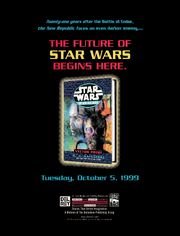
Vector Prime promo
The publication of The New Jedi Order was anticipated by magazine ads, posters, postcards, a television commercial, and later author tours to promote the series. When Vector Prime initially released, it spent four weeks on the New York Times Bestsellers List.[4] Following this initial success, every subsequent novel in the series—all 19 books—would make the Bestsellers List.[54] This feat would go on to make it the longest continuous NYT Bestselling series in Star Wars history. By the end of 2005, the series had sold over 4 million books worldwide.[55] The death of Chewbacca in Vector Prime received widespread coverage in the form of articles, memorials, and tributes by newspapers across the United States after the book's release.[56] The final book of the series, The Unifying Force, spent two weeks on the Bestsellers List and was promoted by a six-city author tour for the novel, with James Luceno visiting Seattle, Indianapolis, Phoenix, Minneapolis, San Diego and Washington, D.C to promote the novel, as well as giving radio interviews and giving away New Jedi Order baseball caps at the events.[57] The publication of the series also spawned the release of a number of Hasbro action figures for the series, as part of its Legacy and Vintage Collections.
R. A. Salvatore remarked in 2015 at the Salt Lake Comic Con that most of the response to Vector Prime that he had received was positive, despite a small number of fans sending death threats over the death of Chewbacca.[58] Michael A. Stackpole also commented positively upon the series at the event, stating that "It made the characters vulnerable. It made people actually worry when it looked like someone was going to die."[58] Troy Denning remarked upon working on the series with such an ensemble cast of writers, saying, "It was a lot of fun. The brainstorming sessions we had at Skywalker Ranch were just a blast," while noting the high level of coordination it required between so many different authors sometimes posed "a little bit more of a coordination headache," requiring authors to coordinate with authors several books ahead and several books behind their point in the series.[47] Denning would remark, "As many pages as we wrote in manuscript, we probably wrote that many pages again in emails" simply to make the series all fit together from book to book.[47] Walter Jon Williams, author of Destiny's Way, said in 2009, "I got more positive fan reaction from that one book than from anything else I've ever written, and I'd very much like to thank the fans for reading so carefully, and for caring."[59] James Luceno, principal architect of the New Jedi Order and the author who reviewed every manuscript of the series as it came in, remarked after the completion of the series, "From the start, The New Jedi Order drew a sizable readership, even in the face of competition from the prequel novels, the comics, and other Star Wars related series. So there's some sense of accomplishment in having been able to hold the interest of so many readers. It was also gratifying to see Troy Denning, Greg Keyes, Matt Stover, and others receive much-deserved acclaim for their individual efforts."[48]
Timothy Zahn felt the deaths of major characters in The New Jedi Order and subsequent Star Wars book series strayed from the "feel" of Star Wars, stating that though second-tier characters might die in war, he believed first-tier characters should always survive each story.[60] He did mention, however, "I'm not really familiar with the overall story line of that series, so I can't really comment on whether the death was a necessary part of the story line."[60] The New Jedi Order authors and editors felt that after almost a decade of Bantam stories, there was a demand for stories that could risk the primary characters' lives in real ways, where not everyone was guaranteed to make it through to the end. On this subject, during the Round Robin New Jedi Order Interview, editor Lucy Wilson reflected, "Good things happen and bad things happen in the Star Wars universe—as in our own world."[21] Sue Rostoni added: "We wanted the NJO stories to have more of the feel of reality, with conflict and emotion. By shaking up the universe, we felt we were adding an emotional depth to the stories that wasn't there before, and we were confident that our readers were up to the challenge."[21] Randy Stradley alleged that Del Rey used an invasion idea originating with Dark Horse and took it in directions they did not intend.[source?] However, authors Tom Taylor and John Ostrander read and enjoyed the series, going on to use material from the novels in the comic series Invasion and Legacy, respectively.
In an interview published in The New Jedi Order: The Unifying Force, Shelly Shapiro, the Editorial Director of Del Rey, expressed some regret over the timing of the novel The New Jedi Order: Star by Star, coming so soon after the September 11 attacks.[21]
Media[]
Television commercial[]
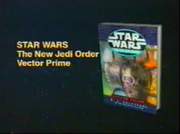
In 1999, Mark Hamill reprised his role as Luke Skywalker in a brief speaking role for the series. Hamill spoke as Luke Skywalker in a television commercial for the first novel in the series, Vector Prime. In the commercial, released on the Sci Fi Channel in late 1999, he recalls the state that the galaxy is in at the present, compared to the times of the Empire.[61] An independently remastered version of the commercial was later released on YouTube.[62]

